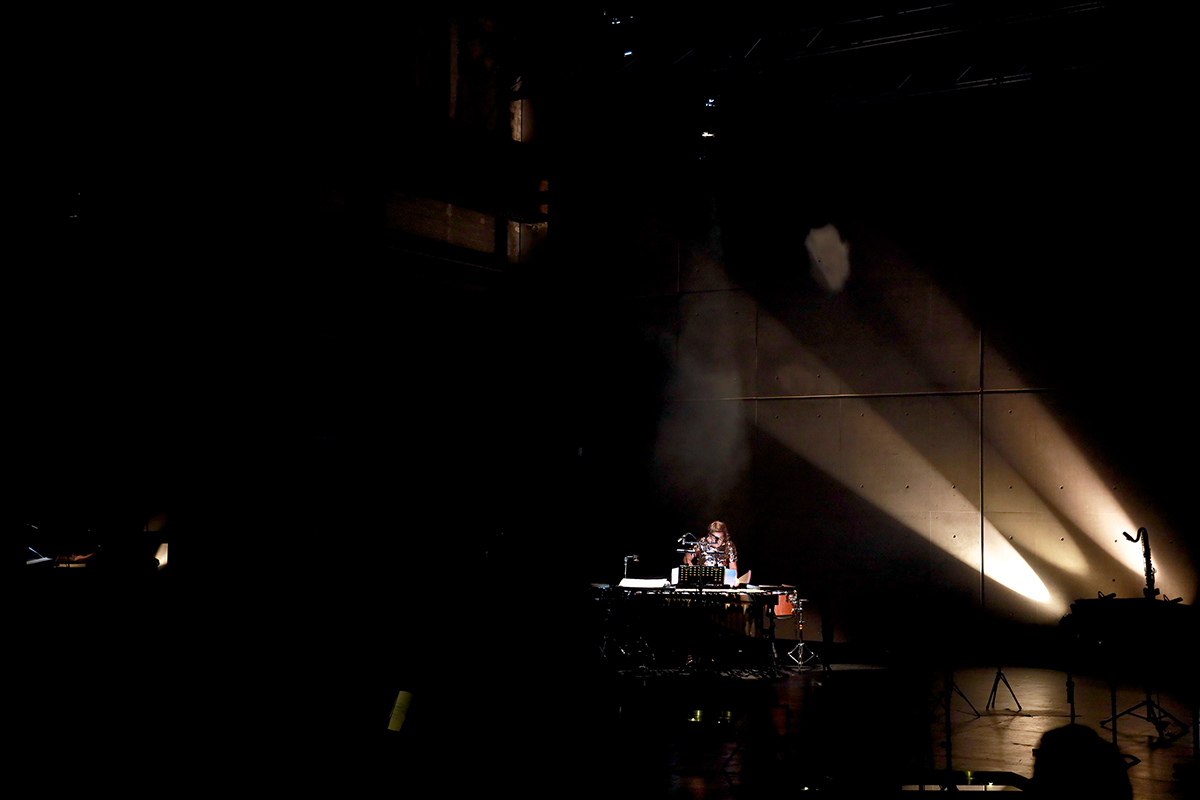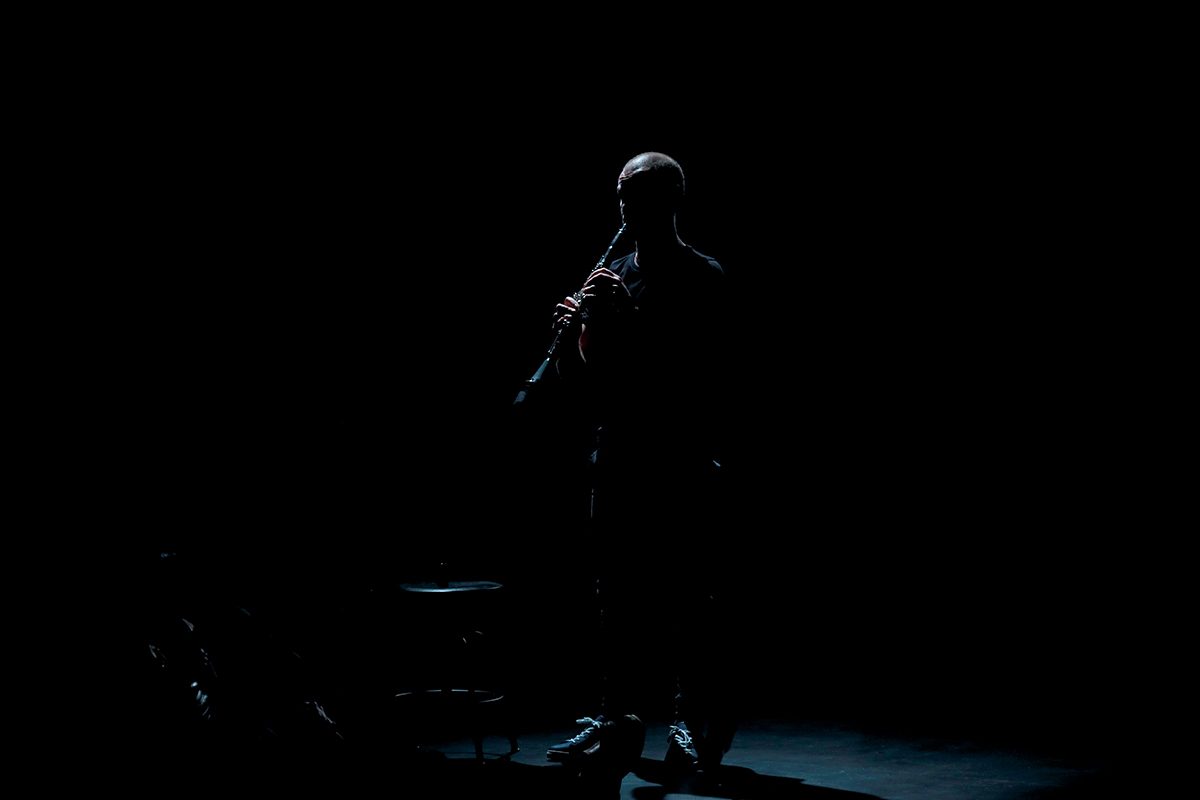
Ensemble Offspring’s not so lonely hemispheres
Lone Hemispheres, the curious title of Ensemble Offspring’s recent concert of works for solo performance at Carriageworks, suggests separation anxiety—what defines a hemisphere but a whole? The featured southern hemisphere composers—Australians Elizabeth Younan, Tristan Coelho and Damien Ricketson—are perhaps more akin to young planets in the gravitational pull of older ones—the Italian modernists Franco Donatoni and Luciano Berio—divided by some 50 years of negligible time-space. Whatever the significance of the metaphor, designer Michelle St Anne emphasises isolation with, in turn, each soloist half-shadowed at the base of a high cone of misty light and each of the six performances newly positioned amid small softly lit sculptural forms, lending the space a cosmological ambience, apt for lone voices in the vastness of the universe.
The organic naturalism of the cellular growth of Donatoni’s Soft (1989) for bass clarinet—warm, velvety, brief utterances, each progressively more expressive, with small swellings, flourishes, deep recurrent punctuations, numerous rippling ascents and a final vertiginous ride down—is deeply engaging in Jason Noble’s riveting performance. Later in the program Noble premieres Damien Ricketson’s Borderlines (2019) for clarinet, a very different work, although seemingly akin to its Italian forebears in its conversational ease, this time with much longer utterances but each, it seems, returning in chorus as the work progresses via a small blue tooth speaker placed in the bell of the clarinet and activated by Noble via the iPad graphic score. This other ‘voice’ is texturally unusual, soft, distant and haunting. In his program note, Ricketson describes this short composition’s structure thus: “A thought twists and frays, tangling in a lump. Knotted like a skein, the line coils against itself in search of open passage only to grind its body into wisp-like filaments. Permeable, formless and free.” The effect seemed less busy than suggested here, but the composition is quite magical, perhaps warranting greater duration so the listener might more fully register the performance’s internal dialogue.
True to the tenor of the concert’s Italian modernist influences, Elizabeth Younan’s Fantasia (2019) for flute, premiered by Lamorna Nightingale, has, writes the composer, a “free and improvisatory construction. The manipulation of small musical cells and their gradual development form the modus operandi of the work.” Fantasia flows like a burbling stream, bounding cell to cell and rising in sprightly ascents even when joined by asynchronous bass drum kicks (from the flautist’s heel) to evoke something like a quirky pipe band. Later, Nightingale eloquently met the challenging pace and pitch changes of Berio’s Sequenza I (1958), not least in the deep trilling and high fluttering, amid lucid long notes, in the thrilling last third or so of the work.
Claire Edwardes performed Tristan Coelho’s A line is a dot that went for a walk (2018) for vibraphone and other percussion. The title is a sentence from painter Paul Klee that inspired the composer; it fits well with Younan and Rickertson’s notes on structure. Coelho writes, “The piece, in two movements, counterposes a meditative and spacious style of music linked with nature against a groove/loop-based feel, playing with glitches and ‘hard cuts’, aligned with technology.” He adds “a nod to the classic vibraphone solo, Omar (1985), by Donatoni,” with which Edwardes will complete the concert. The first part of A line… feels gently conversational, lilting, sweetened with high note chiming and almost tripping into melody. It’s always spacious even when suddenly hesitant or urgent. Pronounced single drum beats, sharp loud/soft shifts and faster pacing make for a more driven, angular second part, until the last few minutes deliver a delicious return to the lyrical spirit of the contemplative first. Donatoni’s more wide-ranging Omar, a beautiful exploration of instrumental possibilities evident in Edwardes’ deeply engaged vibraphone playing, reveals Coelho’s ‘nod’ had been realised within a more formal structure, rich in variation, its dots walking and running in constellating lines.
Within the concert’s unifying stage ambience, Ensemble Offspring’s lone hemispheres were made whole with the soloists’ dextrous execution of Italian modernist classics and compelling Australian works by composers who embrace past innovations while cogently pursuing their own.
–
Carriageworks & Ensemble Offspring, Lone Hemispheres 2, composers Elizabeth Younan, Tristran Coelho, Damien Ricketson, Franco Donatino, Luciano Berio, performers Jason Noble, Lamorna Nightingale, Claire Edwardes; Carriageworks, Sydney, 7 Nov
Top image credit: Claire Edwardes, Lone Hemispheres, Ensemble Offspring, photo Nathaniel Fay







